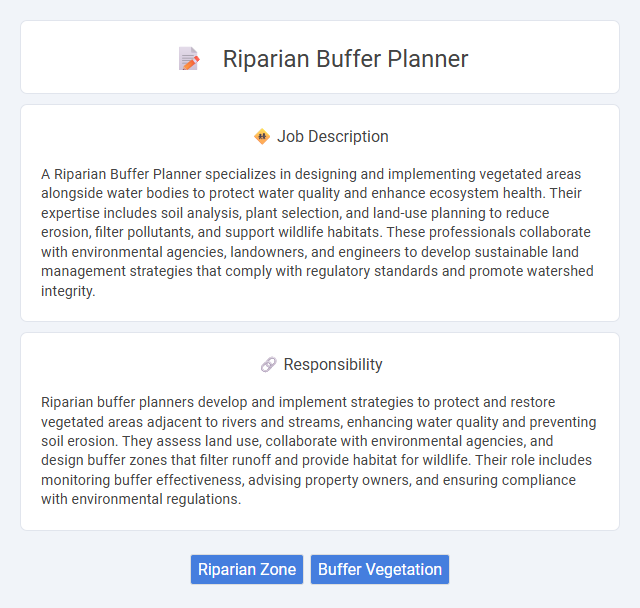
A Riparian Buffer Planner specializes in designing and implementing vegetated areas alongside water bodies to protect water quality and enhance ecosystem health. Their expertise includes soil analysis, plant selection, and land-use planning to reduce erosion, filter pollutants, and support wildlife habitats. These professionals collaborate with environmental agencies, landowners, and engineers to develop sustainable land management strategies that comply with regulatory standards and promote watershed integrity.
Individuals with a strong interest in environmental conservation and a background in ecology, forestry, or environmental science will likely be suitable for a Riparian Buffer Planner role. Those comfortable with fieldwork, data analysis, and community collaboration may find the job aligns well with their skills and preferences. Candidates who prefer office-based tasks without outdoor exposure might find this position less fitting.
Qualification
Riparian buffer planner jobs require expertise in environmental science, ecology, or natural resource management, often necessitating a bachelor's or master's degree in these fields. Proficiency in GIS mapping, hydrology, and knowledge of local and federal environmental regulations are essential for designing effective buffer zones. Strong analytical skills and experience in habitat restoration, soil conservation, or water quality assessment enhance a candidate's qualifications for ensuring sustainable riparian ecosystem management.
Responsibility
Riparian buffer planners develop and implement strategies to protect and restore vegetated areas adjacent to rivers and streams, enhancing water quality and preventing soil erosion. They assess land use, collaborate with environmental agencies, and design buffer zones that filter runoff and provide habitat for wildlife. Their role includes monitoring buffer effectiveness, advising property owners, and ensuring compliance with environmental regulations.
Benefit
Riparian buffer planners likely enhance watershed health by designing and implementing vegetation zones that reduce soil erosion and filter pollutants before they reach water bodies. Their work probably supports biodiversity by creating habitats for wildlife and stabilizing stream banks. These buffers may also contribute to improved water quality and flood mitigation, benefiting both ecosystems and nearby communities.
Challenge
Riparian buffer planner roles likely involve the challenge of balancing environmental protection with land use demands, requiring careful assessment of vegetation zones to reduce erosion and improve water quality. The complexity of coordinating with multiple stakeholders, such as landowners, government agencies, and conservation groups, may increase the difficulty of implementing effective buffer zones. Adaptation to varying regulatory requirements and site-specific ecological conditions probably adds another layer of challenge to the job.
Career Advancement
Riparian buffer planner roles offer significant career advancement opportunities through specialization in environmental management, ecosystem restoration, and sustainable land use planning. Professionals in this field can progress to senior environmental consultant positions, project management roles, or policy advisory capacities within governmental and non-governmental organizations. Mastery in Geographic Information Systems (GIS), hydrology, and regulatory compliance enhances prospects for leadership and higher-level strategic planning responsibilities.
Key Terms
Riparian Zone
Riparian buffer planners specialize in designing and implementing vegetated areas adjacent to water bodies to enhance water quality, reduce erosion, and provide habitat for wildlife. These professionals assess land use, soil types, and hydrology within riparian zones to create effective buffer strips that filter pollutants and stabilize stream banks. Their expertise supports ecosystem restoration and compliance with environmental regulations aimed at protecting aquatic environments.
Buffer Vegetation
Riparian buffer planners specialize in designing and managing vegetative zones adjacent to water bodies to improve water quality and prevent soil erosion. They select native plant species that enhance habitat biodiversity while filtering pollutants from agricultural or urban runoff. Effective buffer vegetation planning supports ecosystem resilience and compliance with environmental regulations.
 kuljobs.com
kuljobs.com